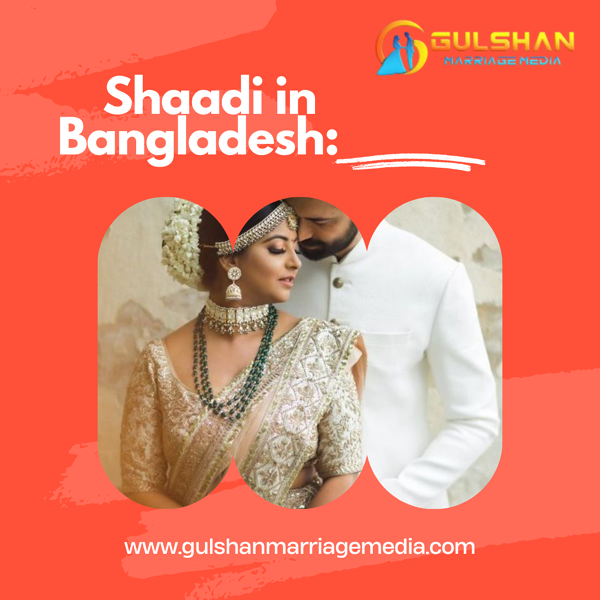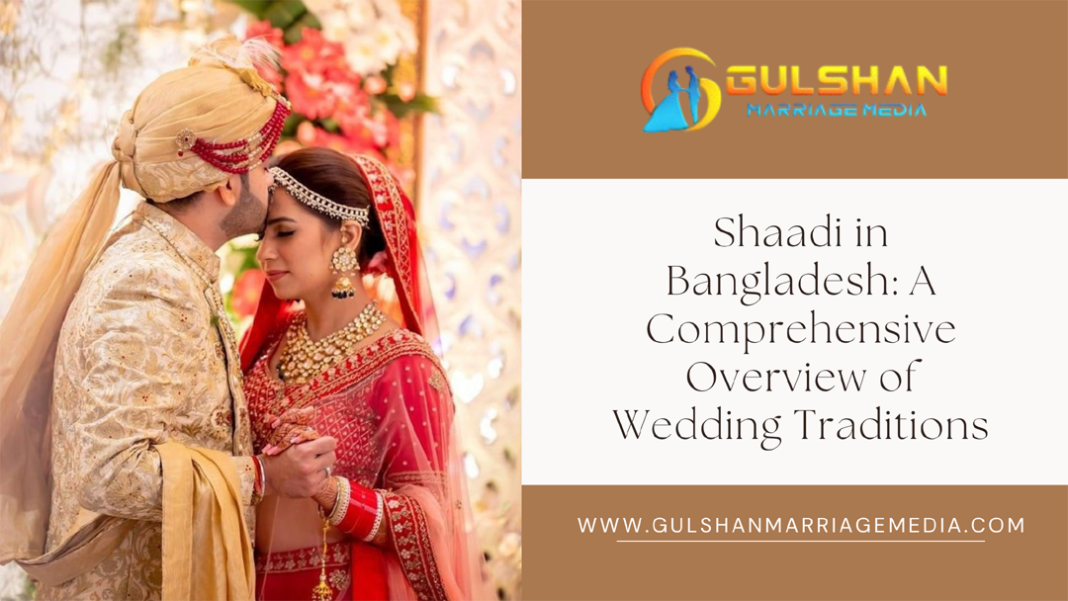Most Shaadi in Bangladesh: A Comprehensive Overview of Wedding Traditions on 2025
Shaadi in Bangladesh:Shaadi, or marriage, is one of the most significant events in the life of an individual, particularly in Bangladesh. It is a social and cultural institution that brings together families, communities, and traditions. The wedding process in Bangladesh is deeply rooted in the country’s diverse cultural, religious, and historical heritage. While the general elements of a marriage remain consistent, each region, community, and family adds its unique customs to the celebration. This article will explore the various traditions, rituals, and customs associated with a Bangladeshi shaadi, along with the significance of each phase.

1. Introduction to Shaadi in Bangladesh
In Bangladesh, marriage is viewed as more than just a union between two individuals; it is a bond between two families. The ceremony is an elaborate affair, usually spanning several days, and involves numerous customs that reflect the country’s rich cultural traditions. Whether one belongs to a Muslim, Hindu, Christian, or indigenous community, marriage is considered a highly auspicious occasion, and the entire process is a blend of joy, rituals, and celebrations.
2. Pre-Wedding Traditions
Before the actual wedding ceremony takes place, several pre-wedding rituals occur. These events are crucial in setting the tone for the wedding and are filled with both joy and solemnity.
a) Proposal and Engagement (Roka or Nikah)
The first step toward marriage is the proposal, which is often arranged by the families. In Muslim communities, the proposal is called Nikah, and it takes place when both families agree to the marriage. An engagement ceremony may follow, which is known as the Roka in some cultures. The engagement is usually a private affair involving close family members, where the families exchange gifts and discuss the wedding date. The groom’s family might also offer the bride a token gift as a symbol of their commitment to the marriage.
For Hindus in Bangladesh, the engagement ritual is known as “Saptapadi” or “Bashi Biye” depending on the region. It involves the exchange of vows, gifts, and ceremonial rituals, often with a priest’s blessing.
b) Henna Night (Mehendi or Gaye Holud)
One of the most anticipated pre-wedding rituals is the henna ceremony, called Mehendi in many Muslim communities and Gaye Holud in Bengali weddings. This ceremony takes place a day or two before the wedding and is a significant occasion, particularly for the bride. The bride’s hands and feet are decorated with intricate henna designs, symbolizing beauty, love, and good fortune.
The Gaye Holud involves the groom’s and bride’s families coming together for a fun-filled event. In rural areas, the bride’s relatives perform a traditional dance, applying turmeric (called Haldi) on the bride and groom. The ceremony symbolizes the purification of the couple and the beginning of their marital life.
c) Bashor Ghar
The Bashor Ghar is a ritual held just before the wedding ceremony, where the groom visits the bride’s house. The groom’s family brings gifts and flowers for the bride, and the groom is typically asked to offer a token of respect to the bride’s parents.
3. The Wedding Day Rituals
The wedding day in Bangladesh is an extravagant affair, and every detail is carefully planned. It involves several rituals that vary between different regions and religious communities, but all hold symbolic importance.
a) Nikah (Islamic Wedding)
For Muslims in Bangladesh, the Nikah is the main wedding ceremony. It is a formal contract between the bride and groom, witnessed by two individuals. The ceremony is presided over by an Imam or a religious scholar. In a traditional Muslim wedding, the bride and groom exchange vows in the presence of their families, and the marriage contract is signed.
The groom gives the bride a Mahr, which is a financial gift as part of the Nikah contract. The amount can vary, but it symbolizes the groom’s commitment and respect for the bride.
b) The Hindu Wedding Ceremony
In Hindu Bengali weddings, the ceremony is often longer and involves many rites and rituals. The Saat Phere or Seven Circles is a significant part of the ceremony. The bride and groom walk around a sacred fire seven times, each round symbolizing a vow they make to each other for a prosperous life. The priest chants sacred mantras, invoking blessings from the gods.
The Sindoor ceremony, in which the groom applies a red powder to the bride’s forehead, symbolizes the bride’s new status as a married woman. Additionally, the Mangal Sutra or sacred necklace is tied by the groom around the bride’s neck to signify the bond of marriage.
c) Christian Wedding Rituals
Christian weddings in Bangladesh often follow a church-based ceremony, where vows are exchanged in front of the congregation. The couple is blessed by the priest, and the marriage is solemnized in the eyes of God. This is followed by the signing of the marriage certificate, making the union legal. The church ceremony often includes hymns, readings from the Bible, and prayers.
4. Post-Wedding Traditions
After the wedding ceremony, there are several post-wedding rituals that are significant in Bangladeshi culture. These traditions are often aimed at welcoming the bride into her new family and ensuring a prosperous future for the couple.
Post-wedding traditions in Bangladesh include the emotional Bidayi, where the bride bids farewell to her family, and the Reception or Ashirbad, a celebration hosted by the groom’s family. Additionally, the Griha Pravesh, the bride’s first entry into her new home, marks a significant transition to married life
a) Bidayi (Farewell Ceremony)
The Bidayi is an emotional moment in a Bangladeshi wedding. This ceremony marks the bride’s departure from her parental home to begin her new life with her husband’s family. The bride is usually accompanied by her family members, and her relatives bid her a tearful goodbye. The groom’s family then takes the bride to her new home. The bride’s family may gift her with household items and jewelry for her new life.
b) Reception Party (Reception or Ashirbad)
Following the wedding, the groom’s family hosts a reception or “Ashirbad” to celebrate the newlyweds’ union. The reception is typically a grand affair, with lavish feasts, music, and dance. It is a way for the bride to meet and greet extended family members and friends of the groom’s side.
In rural areas, a more intimate version of the reception is held, with fewer guests but the same emphasis on joy and blessings. A highlight of the reception is often a performance of traditional Bengali songs, dances, and folk music.
c) Griha Pravesh (Entering the Husband’s Home)
After the wedding, the bride enters her new home for the first time. In Hindu and some Muslim communities, the bride’s first entry into the home is an important ceremony, known as Griha Pravesh. The groom’s family performs several rituals to ensure the bride’s smooth transition into her new life. The bride is often asked to touch the threshold of the door with her feet as a sign of respect for the house.
5. Cultural and Regional Variations
While the above rituals provide a general overview of the Bangladeshi shaadi process, there are significant cultural and regional variations in how weddings are conducted. The wedding practices in urban areas may differ from those in rural regions, and there are different traditions followed by the various ethnic communities within Bangladesh.
a) Bengali Muslims and Hindus
Bengali Muslims and Hindus share many common cultural practices, such as the Gaye Holud and Bashor Ghar. However, their religious ceremonies differ, with Muslims focusing on the Nikah and Hindus on the Saat Phere. Bengali Muslims typically wear traditional attire, such as the Sherwani for the groom and Saree for the bride, while Hindus wear sarees and dhotis for the ceremony.
Bangladesh’s indigenous communities also have distinct wedding traditions that are influenced by their cultural practices. These weddings are often more community-focused, with large gatherings of relatives and friends. Some indigenous groups, such as the Chakma and Marma people, hold their weddings in the presence of village elders who bless the couple in a traditional manner. The ceremonies are less formal and often take place in open spaces, with dances, songs, and feasts.
6. The Significance of Shaadi in Bangladesh
Shaadi in Bangladesh is not just an event but a cultural milestone that strengthens family ties, celebrates love, and marks the beginning of a new chapter in life. It plays a crucial role in preserving traditional values while also adapting to modern influences. Weddings are a reflection of the social fabric of Bangladeshi society, where familial bonds, respect for tradition, and cultural pride are at the heart of the celebration.
Shaadi in Bangladesh holds deep cultural significance, symbolizing the union of two families rather than just individuals. It celebrates love, tradition, and social bonds. Weddings reinforce familial ties, honor cultural heritage, and reflect the values of respect, commitment, and community, making it a pivotal event in Bangladeshi society.
Conclusion
Shaadi in Bangladesh is a rich tapestry of customs and rituals that vary across communities and regions. From the pre-wedding rituals to the final farewells, every step is carefully planned and imbued with meaning. Whether one is from a Muslim, Hindu, Christian, or indigenous background, marriage in Bangladesh represents more than just a union of two individuals—it is a celebration of family, culture, and heritage. Through these elaborate ceremonies, the people of Bangladesh reaffirm their cultural identity and the importance of community, making shaadi an event of immense significance in their lives.





















